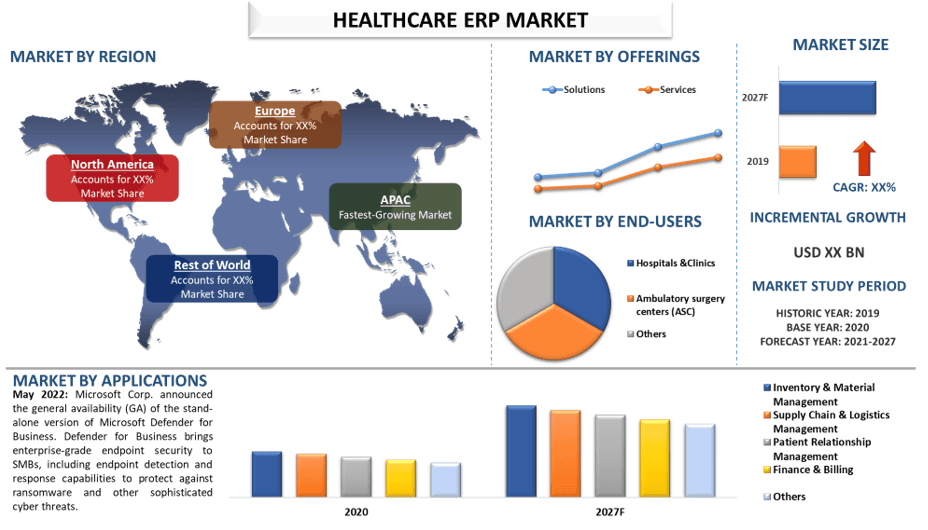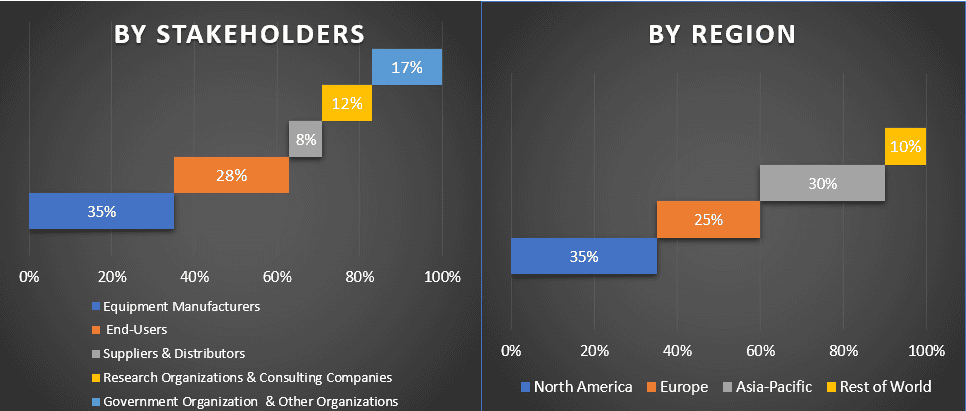- Home
- About Us
- Industry
- Services
- Reading
- Contact Us
Healthcare ERP Market: Current Analysis and Forecast (2021-2027)
Emphasis on Offerings (Solutions and Services); Application (Inventory & Material Management, Supply Chain & Logistics Management, Patient Relationship Management, Finance & Billing, and Others); End-users (Hospitals & Clinics, Ambulatory Surgery Centers (ASC), and Others); and Region/Country

The Healthcare ERP market is predicted to grow at a CAGR of ~6% between 2021 and 2027. Enterprise resource planning (ERP) systems are complete, integrated platforms, either on-premises or in the cloud, managing all aspects of businesses. Furthermore, ERP systems support all aspects of financial management, human resources, and supply chain management, among others. The improving healthcare infrastructure and increasing the number of patients owing to the development of different software and databases. For instance, according to an ONC survey, about 95% of hospitals eligible for the Medicare and Medicaid Electronic health report (EHR) Incentive Program have achieved meaningful use of certified health IT. Moreover, the ERP systems are designed according to provide better healthcare services with better, accurate, and hassle-free treatment. In addition, the ERP systems bring every segment of the healthcare facility under a single roof that integrated system, helps in increasing work efficiency, resulting in the reduced operational cost of the system. Thus, reduced operational cost, better-designed systems, and surging chronic diseases attributes to the future growth of the Healthcare ERP market.
Insights Presented in the Report
“Amongst offerings, solution category is expected to dominate the market”
Based on offerings, the market is bifurcated into solutions and services. The solution segment is further segmented into cloud-based and on-premises. The solution-based ERP is expected to witness significant growth in the forecast period due to the continuous developments in the IT industry and the rising adoption of technologically advanced solutions and services in the healthcare sector. Furthermore, the surging prevalence of chronic diseases coupled with the COVID-19 pandemic boosted the requirement for improved a software solutions. In addition, with the advent of the 5G technology and digitization of public and private healthcare system in developing nations, the cloud-based solution is expected to witness significant growth
Amongst application, a finance & billing segment is expected to have the significant market share
On the basis of application, the market is categorized into inventory & material management, supply chain & logistics management, patient relationship management, finance & billing, and others. Among them, in 2020, the finance & billing category held a significant market share. The growing focus on nations to develop healthcare infrastructure and services coupled with increasing healthcare expenditure is further expected to drive the category’s growth. For instance, According to WHO, the global per capita expenditure on healthcare increased by 12.96% and reached US$ 1,121 in 2019 from US$ 993 in 2015. However, the inventory and material management category is expected to record the robust growth rate over the forecast period. Inventory and material management-based ERP modules provide improved reporting, real-time supply chain management, overall inventory analysis, and inventory planning. As per an article published by Xtelligent Healthcare Media, LLC, in March 2018, the integration of analytics and automation with inventory management has resulted in an efficient order of supplies and management of the organization.
“Amongst End Users, the hospital & clinics segment is likely to capture significant market share during the foreseeable future
Based on end-user, the healthcare ERP market has been segmented into hospitals & clinics, ambulatory surgery centers (ASC), and others. Amongst them, hospitals & clinics are predicted to have a significant market share in the foreseeable future. The rising number of public and private hospitals across the world fueled by increased government and private expenditures on healthcare infrastructure coupled with the growing deployment of digital and technologically sophisticated solutions and systems is expected to result in increased adoption and integration of ERP in the healthcare sector. Furthermore, the adoption of ERP systems is fueled by the growing number of hospital admissions as a result of the increasing incidence of chronic diseases. According to the CDC, 40% of American adults are suffering from chronic diseases and which is expected to grow in the future. In addition, the integration of the diagnostic centers within the hospitals also drives the market of the hospital & clinics.
“North America holds the lion’s share in the Healthcare ERP”
During the forecast period, North America is expected to have a significant market share. The increasing awareness about the severity of the diseases and the increasing geriatric population in the region which is positively influencing the market landscape of the healthcare industry. Continuously increasing the number of online and offline medical consultations in the region has forced countries like the U.S. to focus on Healthcare ERP and deal with greater quantities of healthcare software that can manage many patients at a time. Furthermore, the increasing investment in the healthcare system in the region also contributes to the market growth of the Healthcare ERP. For instance, the healthcare expenditure of Mexico is increasing by 3.2% from 2016 to 2019 which accounted for US$ 1,076 in 2016 and reached US$ 1,111 in 2019. Moreover, the rise in demand for advanced technological solutions among healthcare professionals and clinicians to deliver high-quality care to patients drives the market share of the Healthcare ERP in the region.
Reasons to buy this report:
- The study includes market sizing and forecasting analysis validated by authenticated key industry experts
- The report presents a quick review of overall industry performance at one glance
- The report covers an in-depth analysis of prominent industry peers with a primary focus on key business financials, product portfolio, expansion strategies, and recent developments
- Detailed examination of drivers, restraints, key trends, and opportunities prevailing in the industry
- The study comprehensively covers the market across different segments
- Deep dive regional level analysis of the industry
Customization Options:
Healthcare ERP can further be customized as per the requirement or any other market segment. Besides this, UMI understands that you may have your own business needs, hence feel free to connect with us to get a report that completely suits your requirements.
Table of Content
Research Methodology for the Healthcare ERP Analysis (2021-2027)
Analyzing the historical market, estimation of the current market, and forecasting the future market of the Healthcare ERP were the three major steps undertaken to create and analyze the adoption of Healthcare ERP in major regions globally. Exhaustive secondary research was conducted to collect the historical market numbers and estimate the current market size. Secondly, to validate these insights, numerous findings and assumptions were taken into consideration. Moreover, exhaustive primary interviews were also conducted, with industry experts across the value chain of the healthcare ERP. Post assumption and validation of market numbers through primary interviews, we employed a top-down/bottom-up approach to forecasting the complete market size. Thereafter, market breakdown and data triangulation methods were adopted to estimate and analyze the market size of segments and sub-segments the industry pertains to. Detailed methodology is explained below:
Seek More Details About Research Methodology
Analysis of Historical Market Size
Step 1: In-Depth Study of Secondary Sources:
Detail secondary study was conducted to obtain the historical market size of the healthcare ERP through company internal sources such as annual report & financial statements, performance presentations, press releases, etc., and external sources including journals, news & articles, government publications, competitor publications, sector reports, third-party database, and other credible publications.
Step 2: Market Segmentation:
After obtaining the historical market size of the Healthcare ERP, we conducted a detailed secondary analysis to gather historical market insights and share for different segments & sub-segments for major regions. Major segments included in the report as offerings, application, and end-users. Further country-level analyses were conducted to evaluate the overall adoption of healthcare ERP in that region.
Step 3: Factor Analysis:
After acquiring the historical market size of different segments and sub-segments, we conducted a detailed factor analysis to estimate the current market size of Healthcare ERP. Further, we conducted factor analysis using dependent and independent variables such as the increasing digitalization of industries and urbanization in developing countries. A thorough analysis was conducted for demand and supply-side scenarios considering top partnerships, merger and acquisition, business expansion, and product launches in the Healthcare ERP sector across the globe.
Current Market Size Estimate & Forecast
Current Market Sizing: Based on actionable insights from the above 3 steps, we arrived at the current market size, key players in the Healthcare ERP, and market shares of the segments. All the required percentage shares split, and market breakdowns were determined using the above-mentioned secondary approach and were verified through primary interviews.
Estimation & Forecasting: For market estimation and forecast, weights were assigned to different factors including drivers & trends, restraints, and opportunities available for the stakeholders. After analyzing these factors, relevant forecasting techniques i.e., top-down/bottom-up approach was applied to arrive at the market forecast about 2027 for different segments and subsegments across the major markets globally. The research methodology adopted to estimate the market size encompasses:
- The industry’s market size, in terms of value (US$) and the adoption rate of Healthcare ERP across the major markets domestically
- All percentage shares, splits, and breakdowns of market segments and sub-segments
- Key players in the Healthcare ERP in terms of products offered. Also, the growth strategies adopted by these players to compete in the fast-growing market
Market Size and Share Validation
Primary Research: In-depth interviews were conducted with the Key Opinion Leaders (KOLs) including Top Level Executives (CXO/VPs, Sales Head, Marketing Head, Operational Head, and Regional Head, Country Head, etc.) across major regions. Primary research findings were then summarized, and statistical analysis was performed to prove the stated hypothesis. Inputs from primary research were consolidated with secondary findings, hence turning information into actionable insights.
Split of Primary Participants in Different Regions

Market Engineering
Data triangulation technique was employed to complete the overall market estimation and to arrive at precise statistical numbers of each segment and sub-segment of the Healthcare ERP. Data was split into several segments & sub-segments post studying various parameters and trends in the areas of offerings, application, and end-users of the Healthcare ERP.
The main objective of the Healthcare ERP Study
The current & future market trends of Healthcare ERP were pinpointed in the study. Investors can gain strategic insights to base their discretion for investments from the qualitative and quantitative analysis performed in the study. Current and future market trends were determined the overall attractiveness of the market at a regional level, providing a platform for the industrial participant to exploit the untapped market to benefit as a first-mover advantage. Other quantitative goals of the studies include:
- Analyze the current and forecast market size of Healthcare ERP in terms of value (US$). Also, analyze the current and forecast market size of different segments and sub-segments
- Segments in the study include areas of offerings, application, end-users, and region.
- Define and analysis of the regulatory framework for the Healthcare ERP industry
- Analyze the value chain involved with the presence of various intermediaries, along with analyzing customer and competitor behaviors of the industry
- Analyze the current and forecast market size of the Healthcare ERP for the major region
- Major regions studied in the report include North America (U.S, Canada, and Rest of North America), Europe (Germany, United Kingdom, France, Spain, Italy, and Rest of Europe), Asia-Pacific (China, Japan, India, Australia, and Others), and the Rest of the World
- Company profiles of the Healthcare ERP and the growth strategies adopted by the market players to sustain in the fast-growing market
- Deep dive regional level analysis of the industry
Related Reports
Customers who bought this item also bought










